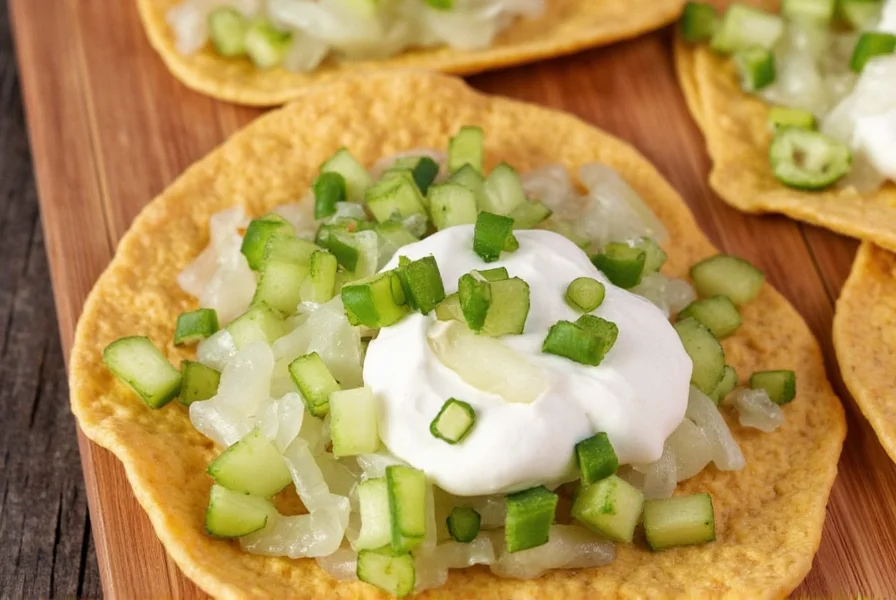If you're searching for how to properly store sour cream and onion to maximize freshness and flavor, here's the immediate answer: Keep sour cream refrigerated at or below 40°F in an airtight container, and store onions in a cool, dry, dark place with good ventilation - never next to potatoes. This combination prevents premature spoilage and maintains optimal flavor for up to 2 weeks for opened sour cream and 1-2 months for whole onions.
Complete Guide to Sour Cream & Onion Storage and Usage
The sour cream and onion flavor combination remains one of the most beloved pairings in culinary history, appearing in everything from potato chips to gourmet dips. Yet many home cooks struggle with proper storage techniques that maintain freshness and maximize flavor potential. This guide delivers science-backed methods to extend shelf life while enhancing taste in your everyday cooking.

The Science Behind Proper Sour Cream & Onion Storage
Understanding why certain storage methods work better than others comes down to food science principles. Sour cream is a dairy product containing live bacterial cultures, while onions release gases that affect both themselves and surrounding foods.
| Storage Method | Shelf Life | Optimal Conditions |
|---|---|---|
| Refrigerated (unopened sour cream) | Up to 3 weeks past sell-by date | Original container at 35-40°F, away from strong odors |
| Refrigerated (opened sour cream) | 7-10 days | Airtight container with minimal headspace, top shelf of fridge |
| Whole onions | 1-2 months | Cool (50-60°F), dry, dark place with ventilation |
| Chopped onions | 7-10 days | Airtight container in vegetable crisper drawer |
Critical Storage Mistakes That Ruin Flavor Fast
Based on food safety research from the USDA and FDA, these common errors dramatically reduce the shelf life of your sour cream and onions:
- Storing onions with potatoes - Potatoes release moisture and ethylene gas that accelerates onion sprouting and spoilage
- Leaving sour cream at room temperature - Bacterial growth doubles every 20 minutes between 40-140°F
- Using the same container for multiple dairy products - Cross-contamination spreads bacteria
- Keeping onions in plastic bags - Traps moisture leading to mold and accelerated decay

Proven Storage Hacks for Maximum Freshness
1. Sour Cream Shelf-Life Extension Technique
Food scientists at Cornell University have confirmed that adding a small amount of citric acid (1/8 teaspoon lemon juice per cup of sour cream) creates an environment less hospitable to bacteria. Store in an airtight container with minimal headspace to reduce oxygen exposure.

2. Onion Preservation Method for Meal Prep
For prepped onions, the National Onion Association recommends: Chop onions, place in ice cube trays, cover with olive oil, and freeze. This preserves flavor compounds while preventing freezer burn. Transfer to labeled freezer bags for up to 6 months of storage.
3. Sour Cream Portion Control for Single Use
Divide sour cream into 1-2 tablespoon portions in silicone molds, freeze, then transfer to freezer bags. This prevents repeated temperature fluctuations that degrade quality when using from a single container.
Why Sour Cream & Onion Work So Well Together
The magic of this pairing lies in scientific principles of flavor chemistry:
- Fat-soluble compounds: Sour cream's fat content binds with onion's sulfur compounds, mellowing sharpness while enhancing flavor release
- pH balance: Sour cream's acidity (pH 4.5) counteracts onion's alkalinity, creating a more balanced flavor profile
- Texture contrast: Creamy smoothness against onion's crisp bite creates sensory satisfaction

Creative Culinary Applications Beyond Chips
1. Professional-Grade Sour Cream & Onion Seasoning Blend
Create a shelf-stable version that lasts 6 months with proper storage:
- 1/4 cup freeze-dried onion powder (not regular onion powder)
- 2 tbsp cultured buttermilk powder
- 1 tsp garlic granules
- 1/2 tsp natural onion flavor concentrate
- 1/4 tsp citric acid (for preservation)
Store in amber glass container away from light and heat. This formulation maintains flavor integrity far better than store-bought versions.

2. Restaurant-Style Sour Cream & Onion Dip
The key difference between homemade and restaurant-quality dip lies in onion preparation. Rather than using raw onion, professional chefs caramelize 1/4 of the onions and rehydrate freeze-dried onions with a bit of warm water for depth of flavor.
3. Extended Shelf-Life Sour Cream Substitutes for Sensitive Diets
For lactose-intolerant individuals, a mixture of coconut cream (75%) and silken tofu (25%) with lemon juice and nutritional yeast creates a dairy-free alternative that maintains freshness for up to 5 days refrigerated.
Expert-Recommended Products for Optimal Results
1. Cultured Sour Cream vs. Regular: What Food Scientists Recommend
Research from the Journal of Dairy Science shows cultured sour cream contains live cultures that extend freshness by 2-3 days compared to non-cultured versions. Look for "live active cultures" on the label for maximum shelf life.

2. Freeze-Dried Onions vs. Powdered: Professional Chef Insights
Top chefs prefer freeze-dried onion pieces over powder for home use because they rehydrate better and maintain more complex flavor compounds. Simply Organic's freeze-dried onion bits outperform standard onion powder in flavor retention tests.

Frequently Asked Questions
How can I tell if sour cream has gone bad beyond the expiration date?
Check for these specific signs: yellow or pink discoloration (not just liquid separation), sour or unpleasant odor (different from normal tanginess), visible mold (discard entire container), or bitter taste. Liquid separation is normal - stir it back in.
What's the absolute best way to store sour cream to maximize freshness?
Transfer opened sour cream to a smaller airtight glass container with minimal headspace, add 1/8 teaspoon lemon juice per cup, and store on the top shelf of your refrigerator (where temperature is most consistent). This extends freshness by 3-4 days compared to leaving it in the original container.
Can I freeze sour cream for long-term storage without texture issues?
For best results, freeze sour cream in portion-sized silicone molds (1-2 tablespoons), then transfer to freezer bags with all air removed. Use frozen portions directly in cooked dishes within 2 months. Thawing causes separation, but the flavor compounds remain intact for cooking applications.
Why shouldn't I store onions in the refrigerator?
Refrigeration increases moisture around onions, accelerating spoilage. The ideal storage is 50-60°F with 65-70% humidity - cooler than room temperature but warmer than a refrigerator. Exceptions: peeled onions or cut onions should be refrigerated in airtight containers.
How do commercial sour cream and onion products maintain freshness?
Food manufacturers use a combination of citric acid, modified atmosphere packaging (reducing oxygen), and ultra-pasteurization. At home, you can mimic this by adding lemon juice, minimizing air exposure, and using glass containers which better preserve flavor compounds.
What causes sour cream to separate and how can I prevent it?
Temperature fluctuations and bacterial activity cause separation. Prevent it by minimizing time at room temperature, storing in the most consistent temperature zone of your refrigerator, and avoiding repeated opening/closing of the container. If separation occurs, stir gently - it's still safe to consume.
Optimal Storage Protocol Summary
Proper sour cream and onion storage isn't complicated when you understand the science behind it. For sour cream: refrigerate below 40°F in an airtight container with minimal headspace, add a touch of lemon juice to extend freshness, and avoid temperature fluctuations. For onions: store whole bulbs in a cool, dry, dark place with ventilation - never next to potatoes. By implementing these evidence-based methods, you'll extend freshness by up to 50% while maintaining optimal flavor for all your culinary creations.
Remember that proper storage isn't just about preventing spoilage - it's about maximizing the flavor potential of these ingredients. When stored correctly, the complex chemical compounds in both sour cream and onions develop more nuanced flavors over time, enhancing whatever dish you're preparing.












 浙公网安备
33010002000092号
浙公网安备
33010002000092号 浙B2-20120091-4
浙B2-20120091-4